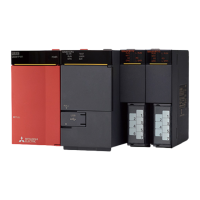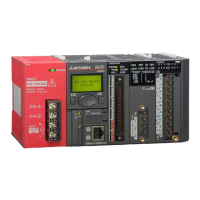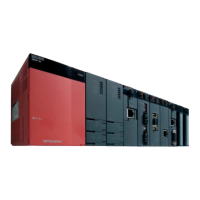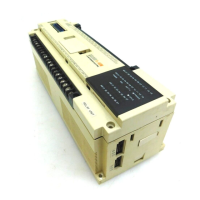12.7 Special Register List
12 - 77
12
TROUBLESHOOTING
9
EMC AND LOW
VOLTAGE
DIRECTIVES
10
LOADING AND
INSTALLATION
11
MAINTENANCE AND
INSPECTION
12
TROUBLESHOOTING APPENDICES INDEX
Table12.19 Special register
Number Name Meaning Explanation
Set by
(When set)
Corresponding
CPU
SD61
I/O module
verify error
number
I/O module
verify error
module number
• The lowest I/O number of the module where the I/O module
verification number took place.
S (Error)
QS
SD62
Annunciator
number
Annunciator
number
• The first annunciator number (F number) to be detected is
stored here.
S (Instruction
execution)
SD63
Number of
annunciators
Number of
annunciators
• Stores the number of annunciators searched.
S (Instruction
execution)
SD64
Table of
detected
annunciator
numbers
Annunciator
detection
number
• When F goes ON due to or , the F numbers
which go progressively ON from SD64 through SD79 are
registered.
• The F numbers turned OFF by are deleted from
SD64 - SD79, and the F numbers stored after the deleted F
numbers are shifted to the preceding registers.
After 16 annunciators have been detected, detection of the
17th will not be stored from SD64 through SD79.
S (Instruction
execution)
SD65
SD66
SD67
SD68
SD69
SD70
SD71
SD72
SD73
SD74
SD75
SD76
SD77
SD78
SD79
SD81
Cause of
error
Cause of error
• When a continuation error occurs, the corresponding bits are
all set to ON.
• Canceling the error, starting up the safety PLC power or
canceling the safety CPU module reset after eliminating the
cause of the error makes the bits go OFF.
S (Error)
OUT F SET F
RST F
SD62 0 50 50 50 50 50 50 50 50 50 50 50 99
(Number
detected)
SD63 0 1 2 3 2 3 4 5 6789 8
0 505050505050505050505099SD64
SD65
SD66
SD67
SD68
SD69
SD70
SD71
SD72
SD73
SD74
SD75
SD76
SD77
SD78
SD79
0 0 25 25 99 99 99 99 99 99 99 99 15
0 0 0 99 0 15 15 15 15 15 15 15 70
0 0 0 0 0 0 70 70 70 70 70 70
65
0 0 0 0 0 0 0 65 65 65 65 65
38
0000000038383838
110
0 0 0 0 0 0 0 0 0 110 110 110
151
0 0 151
0
00000000 151
210
000000000 0 0210
0000000000 0 00
0000000000 0 00
0000000000 0 00
0000000000 0 00
0000000000 0 00
0000000000 0 00
0000000000 0 00
(Number of
annunciators
detected)
(Number
detected)
SET
F50
SET
F25
SET
F99
RST
F25
SET
F15
SET
F70
SET
F65
SET
F38
SET
F110
SET
F151
SET
F210
RST
F50
Bit No. Name of the cause
0
1
2
3
4
5
6
7
8
9
10 to 15
Instantaneous power failure
Battery low
Standard ROM write count excess
TEST MODE continuous RUN tolerance timeout
Scan timeout
Annunciator ON
Safety remote station detection error
Safety remote station product information mismatch
Initial monitoring timeout error
Safety monitoring timeout error
Error monitoring timeout error
Safety remote station data split error
Safety remote command error
Safety remote station link ID error
Safety remote station running number error
Safety remote station reception data error
Empty (fixed to 0)

